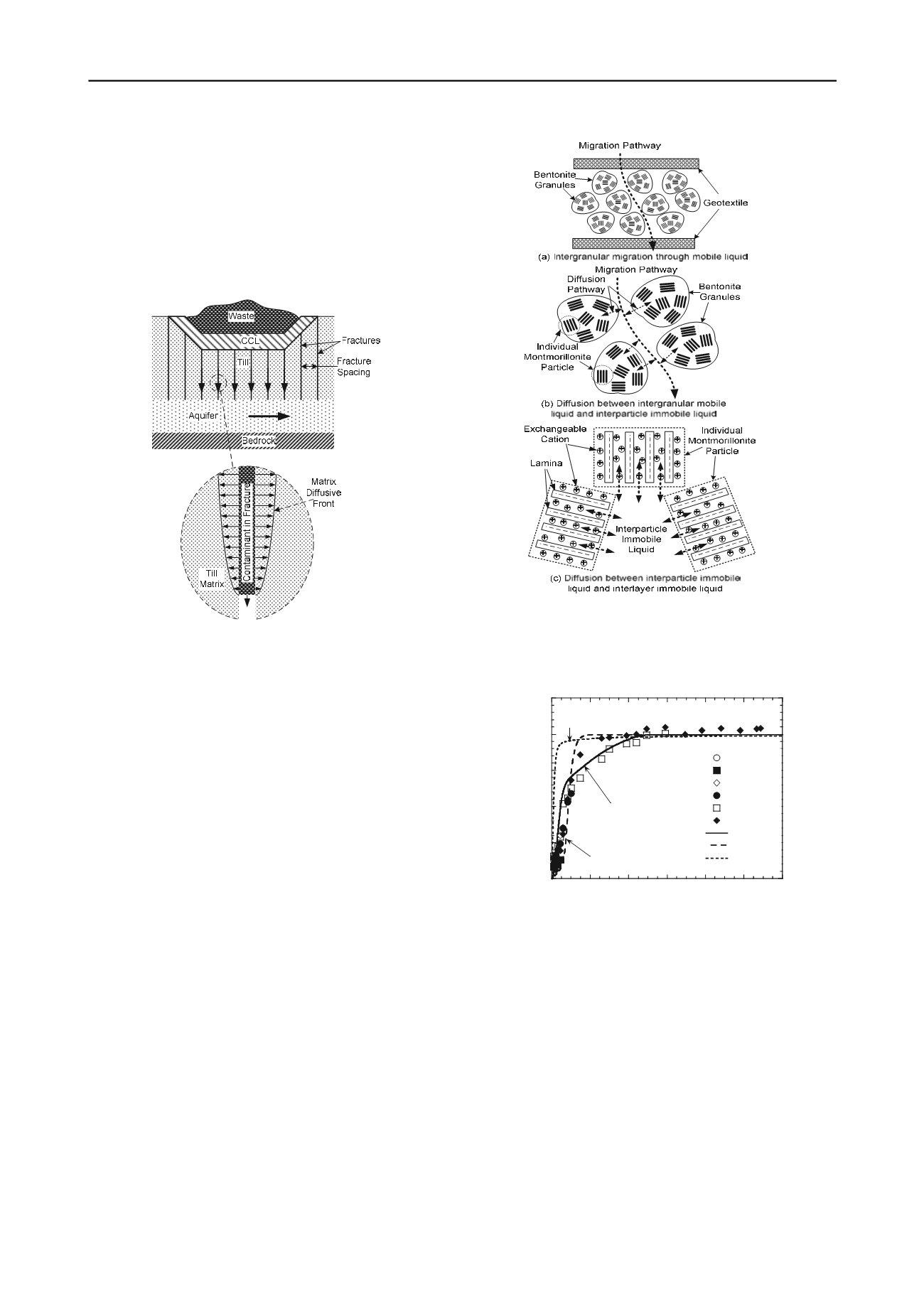
140
Proceedings of the 18
th
International Conference on Soil Mechanics and Geotechnical Engineering, Paris 2013
14
interlayer pores was assumed to be strongly bound by
electrostatic forces and immobile.
Ion exchange was
assumed to occur as cations in the permeant solution
passed through the intergranular pores (Fig. 17a) and
gradually diffuse first into the interparticle pores (Fig. 17b)
and subsequently into interlayer spaces (Fig. 17c). Cation
exchange progressed until equilibrium was established
between cations in the permeant solution and the
montmorillonite surface.
Figure 16. Idealized schematic cross section of lined waste
containment system underline by fractured till and the concept of
attenuation via lateral diffusion from fracture into the intact
surrounding till matrix (modified after Rowe and Booker 1991).
Jo et al. (2006) compared measured breakthrough
curves (BTCs) for calcium (Ca) transport through
specimens of a GCL based on the results of six column
tests versus predicted BTCs based on their theoretical
model. The results of this comparison are shown in Fig. 18,
where
gp
(s
–
1
) is the mass transfer coefficient for diffusion
between the mobile intergranular and the immobile
interparticle liquids, and
pl
(s
–
1
) is the mass transfer
coefficient for diffusion between the immobile interparticle
and interlayer liquids. The predictions obtained with the
model for the base case generally were comparable to the
data, even though the model input parameters were
estimated independently (i.e., the parameters were not
determined from calibration).
The model also predicted reasonably well the changes
in the exchange complex, but the comparison between the
predicted and measured eluted sodium (Na) concentrations
was not quite as favorable (see Jo et al. 2006).
Nonetheless, the results of the study by Jo et al. (2006)
serve as an example of the role that diffusion can play as
an attenuation mechanism during solute transport through
barriers comprised of structured soils.
Figure 17. Effect of diffusion on solute migration through a GCL
containing granular bentonite (modified after Jo et al. 2006 and
Shackelford and Moore 2013).
0
5
10
15
20
25
Test 1
Test 2
Test 3
Test 4
Test 5
Test 6
Predicted
High
Low
0 20 40 60 80 100 120
Ca Effluent Concentration (mmol/L)
gp
= 4.0x10
-5
s
-1
pl
= 4.0x10
-7
s
-1
gp
=
pl
= 4.0x10
-5
s
-1
gp
=
pl
= 6.0x10
-8
s
-1
Pore Volumes of Flow
Figure 18. Measured and predicted breakthrough curves for
calcium (Ca) transport through a GCL containing granular
bentonite where matrix diffusion plays a significant role as an
attenuation mechanism (modified after Jo et al. 2006).
4.4
Liquid-Phase Diffusion in Unsaturated Media
Although the vast majority of studies have focused on
liquid-phase diffusion of chemicals through saturated
porous media, there are a wide variety of applications in
environmental geotechnics where liquid-phase diffusion
through unsaturated porous media can be an important
consideration. Some of the possible applications include
diffusion of salts through unsaturated layers within an
engineered cover system and the potential impact of such
salts on the integrity of GCLs used as a component of the
cover system (e.g., Benson and Meer 2009, Scalia and
Benson 2011, Bradshaw et al. 2013), diffusion of
radionuclides through unsaturated coarse-grained layers
surrounding subsurface radioactive and hazardous waste


